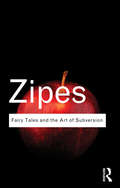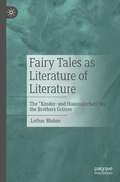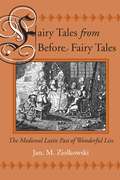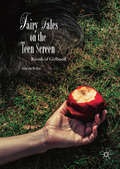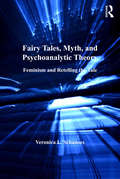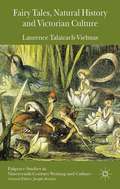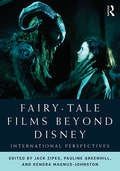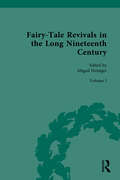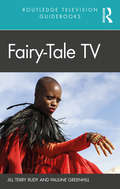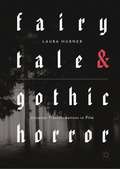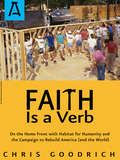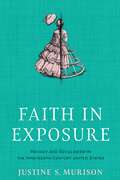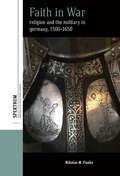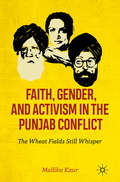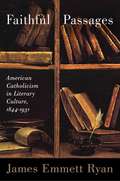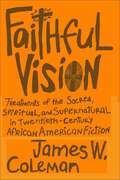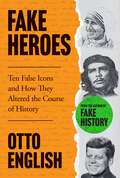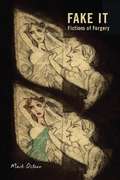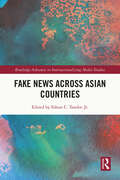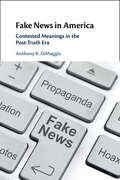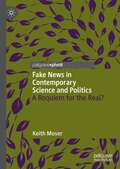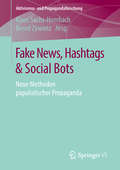- Table View
- List View
Fairy Tales and the Art of Subversion: The Classical Genre For Children And The Process Of Civilization (Routledge Classics)
by Jack ZipesThe fairy tale is arguably one of the most important cultural and social influences on children's lives. But until the first publication of Fairy Tales and the Art of Subversion, little attention had been paid to the ways in which the writers and collectors of tales used traditional forms and genres in order to shape children's lives – their behavior, values, and relationship to society. As Jack Zipes convincingly shows in this classic work, fairy tales have always been a powerful discourse, capable of being used to shape or destabilize attitudes and behavior within culture. How and why did certain authors try to influence children or social images of children? How were fairy tales shaped by the changes in European society in the sixteenth and seventeenth centuries? Zipes examines famous writers of fairy tales such as Charles Perrault, Jacob and Wilhelm Grimm, Hans Christian Andersen and L.Frank Baum and considers the extraordinary impact of Walt Disney on the genre as a fairy tale filmmaker.
Fairy Tales as Literature of Literature: The "Kinder- und Hausmärchen" by the Brothers Grimm
by Lothar BluhmIn this study, the Brothers Grimm's fairy tales are consistently examined as literature out of literature. Through the history of their creation and transformation, it becomes apparent how literary models were re-declared and transformed into the well-known fairy tale narratives, in the course of the editing process by the Brothers Grimm, essentially by Wilhelm Grimm. By means of a series of model studies – including Rapunzel, Jorinde und Joringel and Der Jude im Dorn – it is shown that the Brothers Grimm's fairy tales, contrary to their traditional assessment as 'folk tales', are of literary origin and have a literary character themselves.
Fairy Tales from Before Fairy Tales: The Medieval Latin Past of Wonderful Lies
by Jan M. ZiolkowskiWhen did fairy tales begin? What qualifies as a fairy tale? Is a true fairy tale oral or literary? Or is a fairy tale determined not by style but by content? To answer these and other questions, Jan M. Ziolkowski not only provides a comprehensive overview of the theoretical debates about fairy tale origins but includes an extensive discussion of the relationship of the fairy tale to both the written and oral sources. Ziolkowski offers interpretations of a sampling of the tales in order to sketch the complex connections that existed in the Middle Ages between oral folktales and their written equivalents, the variety of uses to which the writers applied the stories, and the diverse relationships between the medieval texts and the expressions of the same tales in the "classic" fairy tale collections of the nineteenth century. In so doing, Ziolkowski explores stories that survive in both versions associated with, on the one hand, such standards of the nineteenth-century fairy tale as the Brothers Grimm, Hans Christian Andersen, and Carlo Collodi and, on the other, medieval Latin, demonstrating that the literary fairy tale owes a great debt to the Latin literature of the medieval period. Jan M. Ziolkowski is the Arthur Kingsley Porter Professor of Medieval Latin at Harvard University.
Fairy Tales on the Teen Screen
by Athena BellasThis book examines how the fairy tale is currently being redeployed and revised on the contemporary teen screen. The author redeploys Victor Turner's work on liminality for a feminist agenda, providing a new and productive method for thinking about girlhood onscreen. While many studies of teenagehood and teen film briefly invoke Turner's concept, it remains an underdeveloped framework for thinking about youth onscreen. The book's broad scope across teen media--including film, television, and online media--contributes to the need for contemporary analysis and theorisation of our multimedia cultural climate.
Fairy Tales, Myth, and Psychoanalytic Theory: Feminism and Retelling the Tale (Ashgate Studies In Childhood, 1700 To The Present Ser.)
by Veronica L. SchanoesAt the same time that 1970s feminist psychoanalytic theorists like Jean Baker Miller and Nancy Chodorow were challenging earlier models that assumed the masculine psyche as the norm for human development and mental/emotional health, writers such as Anne Sexton, Olga Broumass, and Angela Carter were embarked on their own revisionist project to breathe new life into fairy tales and classical myths based on traditional gender roles. Similarly, in the 1990s, second-wave feminist clinicians continued the work begun by Chodorow and Miller, while writers of fantasy that include Terry Windling, Tanith Lee, Terry Pratchett, and Catherynne M. Valente took their inspiration from revisionist authors of the 1970s. As Schanoes shows, these two decades were both particularly fruitful eras for artists and psychoanalytic theorists concerned with issues related to the development of women's sense of self. Putting aside the limitations of both strains of feminist psychoanalytic theory, their influence is undeniable. Schanoes's book posits a new model for understanding both feminist psychoanalytic theory and feminist retellings, one that emphasizes the interdependence of theory and art and challenges the notion that literary revision involves a masculinist struggle with the writer's artistic forbearers.
Fairy Tales, Natural History and Victorian Culture
by Laurence Talairach-VielmasFairy Tales, Natural History and Victorian Culture examines how literary fairy tales were informed by natural historical knowledge in the Victorian period, as well as how popular science books used fairies to explain natural history at a time when 'nature' became a much debated word.
Fairy-Tale Films Beyond Disney: International Perspectives
by Jack Zipes Pauline Greenhill Kendra Magnus-JohnstonThe fairy tale has become one of the dominant cultural forms and genres internationally, thanks in large part to its many manifestations on screen. Yet the history and relevance of the fairy-tale film have largely been neglected. In this follow-up to Jack Zipes’s award-winning book The Enchanted Screen (2011), Fairy-Tale Films Beyond Disney offers the first book-length multinational, multidisciplinary exploration of fairy-tale cinema. Bringing together twenty-three of the world’s top fairy-tale scholars to analyze the enormous scope of these films, Zipes and colleagues Pauline Greenhill and Kendra Magnus-Johnston present perspectives on film from every part of the globe, from Hayao Miyazaki’s Spirited Away, to Jan Švankmajer’s Alice, to the transnational adaptations of 1001 Nights and Hans Christian Andersen. Contributors explore filmic traditions in each area not only from their different cultural backgrounds, but from a range of academic fields, including criminal justice studies, education, film studies, folkloristics, gender studies, and literary studies. Fairy-Tale Films Beyond Disney offers readers an opportunity to explore the intersections, disparities, historical and national contexts of its subject, and to further appreciate what has become an undeniably global phenomenon.
Fairy-Tale Revivals in the Long Nineteenth Century: Volume I: Fairy-Tale Revivals: Writing Wonder in Transatlantic Ethnic Literary Revivals, 1850–1950
by Abigail HeinigerThis collection opens with marginalized responses to the highly politicized Cinderella traditions in the Anglophone world. In the United States, Cinderella was incorporated into the gendered narrative of the American Dream and narratives of empire in the colonial world, particularly in the mid-1800s. Marginalized writers have responded to these nationalistic colonial traditions in two distinctive ways: clever Cinderellas who negotiate a broken system or passive Cinderellas who die as anti-heroes in disenchanting fairy tales. This dual tradition of marginalized Cinderellas is also apparent across the Anglophone world. Potential texts include the out-of-print works of Sinèad de Valera, excerpts from the novels of Hannah Crafts, Jessie Fauset, and Julia Kavanagh, along with dramas by Ann Devlin, and collected oral tales.
Fairy-Tale Revivals in the Long Nineteenth Century: Volume II: Fairy- Tale Revival Dramas: Writing Wonder in Transatlantic Ethnic Literary Revivals, 1850–1950
by Abigail HeinigerVolume two explores the way a wide range of classic princess tales written by marginalized writers. Rapunzel and Snow White, with their pale skin or long ropes of golden hair, are particularly popular vehicles for exploring and challenging racialized constructions of beauty. Marriage is the traditional vehicle of a happy ending in Princess tales, so marginalized responses to these tales also inherently respond to the doubly colonized position of women in the Anglophone world. The institution of marriage typically exposes the institutional oppression of colonized women. Authors include Charles Chesnutt, Jessie Fauset, Julia Kavanaugh, George Edwards, some of the unpublished manuscripts of Jewish-Australian author Joseph Jacobs, and the earliest work of Sinèad de Valera, as well as fin-de-siècle illustrators such as Harry Clarke, and collected oral tales.
Fairy-Tale Science
by Suzanne MagnaniniBetween 1550 and 1650, Europe was swept by a fascination with wondrous accounts of monsters and other marvels - of valiant men slaying dragons, women giving birth to animals, young girls growing penises, and all manner of fantastic phenomena. Known as 'fairy tales,' these stories had many guises and inhabited a variety of literary texts. The first two collections of such fairy tales published on the continent, Giovan Francesco Straparola's Le piacevoli notti and Giambattista Basile's Lo cunto de li cunti, were greeted with much enthusiasm at home and abroad and essentially established a new literary genre. Contrary to popular thought, Italy, not Germany or France, was the birthplace of the literary fairy tale.This fascination with the marvellous also extended to the worlds of science, medicine, philosophy, and religion, and many treatises from the period focused on discussions of monsters, demons, magic, and witchcraft. In Fairy-Tale Science Suzanne Magnanini looks at these 'science fictions' and explores the birth and evolution of the literary fairy tale in the context of early modern discourses on the monstrous. She demonstrates how both the normative literary theories of the Italian intellectual establishment and the emerging New Science limited the genre's success on its native soil. Natural philosophers, physicians, and clergymen positioned the fairy tale in opposition in opposition to science, fixing it as a negative pole in a binary system, one which came to define both a new type of scientific inquiry and the nascent literary genre. Magnanini also suggests that, by identifying their literary production with the monstrous and the feminine, Straparola and Basile contributed to the marginalization of the new genre.A wide-ranging yet carefully crafted study, Fairy-Tale Science investigates the complex interplay between scientific discourse and an emerging literary genre, and expands our understanding of the early modern European imagination.
Fairy-Tale TV (Routledge Television Guidebooks)
by Pauline Greenhill Jill Terry RudyThis concise and accessible critical introduction examines the world of popular fairy-tale television, tracing how fairy tales and their social and cultural implications manifest within series, television events, anthologies, and episodes, and as freestanding motifs. Providing a model of televisual analysis, Rudy and Greenhill emphasize that fairy-tale longevity in general, and particularly on TV, results from malleability—morphing from extremely complex narratives to the simple quotation of a name (like Cinderella) or phrase (like "happily ever after")—as well as its perennial value as a form that is good to think with. The global reach and popularity of fairy tales is reflected in the book’s selection of diverse examples from genres such as political, lifestyle, reality, and science fiction TV. With a select mediagraphy, discussion questions, and detailed bibliography for further study, this book is an ideal guide for students and scholars of television studies, popular culture, and media studies, as well as dedicated fairy-tale fans.
Fairytale and Gothic Horror: Uncanny Transformations in Film
by Laura HubnerThis book explores the idiosyncratic effects generated as fairytale and gothic horror join, clash or merge in cinema. Identifying long-held traditions that have inspired this topical phenomenon, the book features close analysis of classical through to contemporary films. It begins by tracing fairytale and gothic origins and evolutions, examining the diverse ways these have been embraced and developed by cinema horror. It moves on to investigate films close up, locating fairytale horror, motifs and themes and a distinctively cinematic gothic horror. At the book’s core are recurring concerns including: the boundaries of the human; rational and irrational forces; fears and dreams; ‘the uncanny’ and transitions between the wilds and civilization. While chronology shapes the book, it is thematically driven, with an interest in the cultural and political functions of fairytale and gothic horror, and the levels of transgression or social conformity at the heart of the films.
Faith Is a Verb: On the Home Front with Habitat for Humanity and the Campaign to Rebuild America (and the World)
by Chris GoodrichFaith is a Verb is both an account of the author's five years volunteering with Habitat for Humanity and a history of the organization, which Goodrich sees as a model institution founded on grassroots, Jeffersonian principles. The reader looks over his shoulder as Goodrich helps restore a burned-out drug den to its Victorian glory in Bridgeport, Connecticut; understands the yawning gap between the rich and poor as he straightens nails with an impoverished teenager in the Dominican Republic; senses the importance of volunteer work as he watches, while laying a stone foundation in Paraguay, the Twin Towers fall on 9/11.Goodrich traces Habitat's history back to an unsung American hero, Clarence Jordan, who in the 1940's founded a Christian community in Georgia, Koinonia Farm, dedicated to social and economic justice. Millard Fuller, a millionaire businessman, visited at Koinonia in the early 1970's, and under Jordan's guidance realized he was a "money-holic," gave away his fortune, and in 1976 founded Habitat for Humanity. Goodrich shows how Fuller's Southern Baptist, Friday-night-revival personality helped turn Habitat into the world's largest non-governmental home-builder, his inspirational leadership greatly abetted by the support of former president Jimmy Carter. In a postscript the author describes the crisis Habitat faced when Fuller was forced out following allegations of sexual harassment in 2005. This edition updates the story to 2013, when the organization had "helped build or repair more than 600,000 houses" world-wide.What readers have said about Faith is a Verb:"A great record of how [Habitat for Humanity] got underway and became so significant." -- Tony Campolo, PhD., author of Pray Give Go Do"[S]pirited and intimate....Anyone interested in learning about or volunteering for the organization will find his account richly detailed." -- David Bornstein, author of How to Change the World
Faith in Exposure: Privacy and Secularism in the Nineteenth-Century United States (Early American Studies)
by Justine S. MurisonRecent legal history in the United States reveals a hardening tendency to treat religious freedom and sexual and reproductive freedom as competing, even opposing, claims on public life. They are united, though, by the fact that both are rooted in our culture’s understanding of privacy. Faith in Exposure shows how, over the course of the nineteenth century, privacy came to encompass such contradictions—both underpinning the right to sexual and reproductive rights but also undermining them in the name of religious freedom.Drawing on the interdisciplinary field of secular studies, Faith in Exposure brings a postsecular orientation to the historical emergence of modern privacy. The book explains this emergence through two interlocking stories. The first examines the legal and cultural connection of religion with the private sphere, showing how privacy became a moral concept that informs how we debate the right to be shielded from state interference, as well as who will be afforded or denied this protection. This conflation of religion with privacy gave rise, the book argues, to a “secular sensibility” that was especially invested in authenticity and the exposure of hypocrisy in others.The second story examines the development of this “secular sensibility” of privacy through nineteenth-century novels. The preoccupation of the novel form with private life, and especially its dependence on revelations of private desire and sexual secrets, made it the perfect vehicle for suggesting that exposure might be synonymous with morality itself. Each chapter places key authors into wider contexts of popular fiction and periodical press debates. From fears over religious infidelity to controversies over what constituted a modern marriage and conspiracy theories about abolitionists, these were the contests, Justine S. Murison argues, that helped privacy emerge as both a sensibility and a right in modern, secular America.
Faith in War: Religion and the Military in Germany, c.1500-1650 (Spektrum: Publications of the German Studies Association #31)
by Nikolas M. FunkeWhile the social and cultural history of the early modern military has greatly advanced in the last few decades, the religious dimension of the military life in the Holy Roman Empire between 1500 and 1650 has hardly been explored. The Reformation brought profound political, social and cultural upheavals, but the religiosity of the men and women who followed the Christian life in the chaos of war still represents a large gap in the historiography. Faith in War shows that confessional antagonisms lost much of their meaning during war and coexistence became a fact of army life. Connecting military and civilian social and cultural history in these ways, Nikolas Funke’s case study on this period brings new life to important current historiographical discussions in a military context, including stereotyping, confessionalization, social discipline, deviance, toleration, religious violence, and the culture of death.
Faith, Gender, and Activism in the Punjab Conflict: The Wheat Fields Still Whisper
by Mallika KaurPunjab was the arena of one of the first major armed conflicts of post-colonial India. During its deadliest decade, as many as 250,000 people were killed. This book makes an urgent intervention in the history of the conflict, which to date has been characterized by a fixation on sensational violence—or ignored altogether. Mallika Kaur unearths the stories of three people who found themselves at the center of Punjab’s human rights movement: Baljit Kaur, who armed herself with a video camera to record essential evidence of the conflict; Justice Ajit Singh Bains, who became a beloved “people’s judge”; and Inderjit Singh Jaijee, who returned to Punjab to document abuses even as other elites were fleeing. Together, they are credited with saving countless lives. Braiding oral histories, personal snapshots, and primary documents recovered from at-risk archives, Kaur shows that when entire conflicts are marginalized, we miss essential stories: stories of faith, feminist action, and the power of citizen-activists.
Faithful Passages: American Catholicism in Literary Culture, 1844-1931
by James Emmett RyanRoman Catholic writers in colonial America played only a minority role in debates about religion, politics, morality, national identity, and literary culture. However, the commercial print revolution of the nineteenth century, combined with the arrival of many European Catholic immigrants, provided a vibrant evangelical nexus in which Roman Catholic print discourse would thrive among a tightly knit circle of American writers and readers. James Emmett Ryan's pathbreaking study follows the careers of important nineteenth-century religionists including Orestes Brownson, Isaac Hecker, Anna Hanson Dorsey, and Cardinal James Gibbons, tracing the distinctive literature that they created during the years that non-Catholic writers like Herman Melville and Emily Dickinson were producing iconic works of American literature. Faithful Passagesalso reveals new dimensions in American religious literary culture by moving beyond the antebellum period to consider how the first important cohort of Catholic writers shaped their message for subsequent generations of readers in the late nineteenth and early twentieth centuries. Perhaps most strikingly, Ryan shows that by the early twentieth century, Roman Catholic themes and traditions in American literature would be advanced in complex ways by mainstream, non-Catholic modernist writers like Kate Chopin and Willa Cather. Catholic literary culture in the United States took shape in a myriad of ways and at the hands of diverse participants. The process by which Roman Catholic ideas, themes, and moralities were shared and adapted by writers with highly differentiated beliefs, Ryan contends, illuminates a surprising fluidity of religious commitment and expression in early U. S. literary culture.
Faithful Vision: Treatments of the Sacred, Spiritual, and Supernatural in Twentieth-Century African American Fiction (Southern Literary Studies)
by James W. Coleman"This is a marvelous and sustained discussion of 'faithful vision' and its significant influence on African American literature." -- American LiteratureIn Faithful Vision, James W. Coleman places under his critical lens a wide array of African American novels written during the last half of the twentieth century. In doing so, he demonstrates that religious vision not only informs black literature but also serves as a foundation for black culture generally. The Judeo-Christian tradition, according to Coleman, is the primary component of the African American spiritual perspective, though its syncretism with voodoo/hoodoo -- a religion transported from West Africa through the West Indies and New Orleans to the rest of black America -- also figures largely. Reviewing novels written mainly since 1950 by writers including James Baldwin, Randall Kenan, Toni Morrison, John Edgar Wideman, Alice Walker, Gloria Naylor, Erna Brodber, and Ishmael Reed, among others, Coleman explores how black authors have addressed the relevance of faith, especially as it relates to an oppressive Christian tradition. He shows that their novels -- no matter how critical of the sacred or supernatural, or how skeptical the characters' viewpoints -- ultimately never reject the vision of faith. With its focus on religious experience and tradition and its wider discussion of history, philosophy, gender, and postmodernism, Faithful Vision brings a bold critical dimension to African American literary studies."An insightful interrogation of the complexities of religious discourse in the African American literary tradition. Because it superbly translates complex spiritual ethos into literary tradition, this remarkable book is a must for anyone interested in intersections of the sacred and the secular in black cultural productions." -- Southern Literary Journal"Faithful Vision both looks intently into faith and shows us how to look." -- Christianity and Literature
Fake Heroes: Ten False Icons and How they Altered the Course of History
by Otto EnglishFrom the author of Fake History, Otto English, comes a shocking yet hilarious look at ten of the greatest liars from our past, examining these previously unquestioned idols and exposing what they were trying to hide.'A brilliant book.' James O'BrienWas Che Guevara really a revolutionary hero?Should Mother Teresa be honoured as a saint?Is Henry V actually England's greatest king?And why does JFK's legend continue to grow?Having exposed some of the greatest lies ever told in Fake History, journalist Otto English turns his attention to some of history's biggest (and most beloved) figures.Whether it's virtuous leaders in just wars, martyrs sacrificing all for a cause, or innovators changing the world for the better, down the centuries supposedly great men and women have risen to become household names, saints and heroes. But just how deserving are they of their reputations?Exploring everything from Captain Scott's reckless hunt for glory and Andy Warhol's flagrant thievery to Coco Chanel's murky Nazi past, Otto English dives into the hidden lives of some of history's most recognisable names. Scrutinising figures from the worlds of art, politics, business, religion and royalty, he brings to light the murkier truths they would rather have kept buried away, at the same time as celebrating the unsung heroes lost to time.Fake Heroes exposes the truth of the past and helps us understand why that matters today.
Fake It: Fictions of Forgery
by Mark OsteenHow many layers of artifice can one artwork contain? How does forgery unsettle our notions of originality and creativity? Looking at both the literary and art worlds, Fake It investigates a set of fictional forgeries and hoaxes alongside their real-life inspirations and parallels. Mark Osteen shows how any forgery or hoax is only as good as its authenticating story—and demonstrates how forgeries foster fresh authorial identities while being deeply intertextual and frequently quite original. From fakes of the late eighteenth century, such as Thomas Chatterton’s Rowley poems and the notorious "Shakespearean" documents fabricated by William-Henry Ireland, to hoaxes of the modern period, such as Clifford Irving’s fake autobiography of Howard Hughes, the infamous Ern Malley forgeries, and the audacious authorial masquerades of Percival Everett, Osteen lays bare provocative truths about the conflicts between aesthetic and economic value. In doing so he illuminates the process of artistic creation, which emerges as collaborative and imitative rather than individual and inspired, revealing that authorship is, to some degree, always forged.
Fake News Across Asian Countries (Routledge Advances in Internationalizing Media Studies)
by Edson C. TandocThis book integrates insights from studies conducted across Asia to provide a comprehensive account of the fake news problem in the region.Emerging from a study on how Singapore stakeholders define, determine, and deal with online falsehoods, the volume expands to cover numerous Asian contexts, all of which have experienced the problem in not only similar but also unique ways, coupled with diverse cultures and media regulatory contexts. Drawing from specific examples and case studies to demonstrate the real-world manifestation of the concepts and theories on fake news, the book grounds academic research in lived experiences.This volume will interest journalism scholars and undergraduate and postgraduate students in the areas of media studies, mass communication, digital media, media literacy, Asian studies, and political communication.
Fake News in America: Contested Meanings in the Post-Truth Era
by Anthony R. DiMaggioThe term 'fake news' became a buzzword during Donald Trump's presidency, yet it is a term that means very different things to different people. This pioneering book provides a comprehensive examination of what Americans mean when they talk about fake news in contemporary politics, mass media, and societal discourse, and explores the various factors that contribute to this, such as the power of language, political parties, ideology, media, and socialization. By analysing a range of case studies across war, political corruption, climate change, conspiracy theories, electoral politics, and the Covid-19 pandemic, it demonstrates how fake news is a fundamentally contested phenomenon, and how its meaning varies depending on the person using the term, and the political context. It provides readers with tools to identify, talk about, and resist fake news, and emphasizes a need for education reform with an eye toward promoting critical thinking and information literacy.
Fake News in Contemporary Science and Politics: A Requiem for the Real?
by Keith MoserThis transdisciplinary book investigates the profound repercussions of living in a post-truth world in which 'alternative facts' and post-truth knowledge claims, often bordering on the absurd, have replaced the real in the collective imagination of millions of people around the planet. Through discussions on climate change denial, the anti-vaccination movement, the January 6th Insurrection and the Russia-Ukraine War, this study explores the gravity of the current 'infodemic,' or the increasing inability of a large segment of the population to distinguish between reality and misrepresentation, and the destabilizing impact this infodemic has on democratic models of governance around the globe, coinciding with the rise of autocratic forms of populism.
Fake News, Hashtags & Social Bots: Neue Methoden populistischer Propaganda (Aktivismus- und Propagandaforschung)
by Klaus Sachs-Hombach Bernd ZywietzDer Band versammelt Beiträge zum Thema der gegenwärtigen „digitalen“ Propaganda, wie sie im Kontext des Populismus eine besondere Rolle spielt. Sie wird als politisch-mediales Phänomen analysiert und als gesellschaftlich-kommunikatives Herausforderung: dies hinsichtlich der Sorge vor der einseitigen Beeinflussung einer neuen, fragmentierten „Masse“ im Netz sowie um die für medienvermittelte Demokratien fundamentale Möglichkeit des vertrauensvollen Austausches von Informationen und Meinungen auf Basis diskursethischer Prinzipien.
Fake News: Separating Truth from Fiction
by Michael MillerWhile popularized by President Donald Trump, the term "fake news" actually originated toward the end of the 19th century, in an era of rampant yellow journalism. Since then, it has come to encompass a broad universe of news stories and marketing strategies ranging from outright lies, propaganda, and conspiracy theories to hoaxes, opinion pieces, and satire—all facilitated and manipulated by social media platforms. This title explores journalistic and fact-checking standards, Constitutional protections, and real-world case studies, helping readers identify the mechanics, perpetrators, motives, and psychology of fake news. A final chapter explores methods for assessing and avoiding the spread of fake news.
